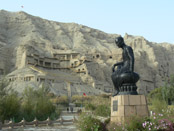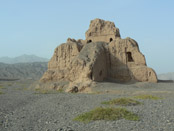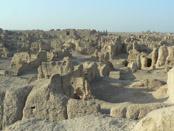This website is dedicated to old languages and history of Central Asia and especially to mutual relations of Indo-European, Altaic, Sino-Tibetan and other languages and peoples.
The website started thanks to the support of the Czech Science Foundation (GAČR), project no. GAP406/12/0655 "Indo-European Language Interference in Central Asia and China" (2012-2015), and will be the platform for other related and continuing projects.

|
part of Kizil Buddhist grottoes near Kucha with the modern statue of famous translator Kumarajiva |

|
stupa from large Buddhist temple in Subashi near Kucha |

|
part of ancient Yarkhoto (in Chinese Jiaohe) city near Turfan |
About the Project
The project Indo-European Linguistic Interference in Central Asia and China funded by the Czech Science Foundation (project code: P406-12-0655, 2012–2015) was dedicated to relations and development of Indo-European and non-Indo-European languages in the Tarim Basin and Central Asia. The use of various methods of linguistic research allowed to discover new findings in the field of etymology, mutual Tocharian-Chinese language contacts, classification and development of Indo-European languages and prehistoric migrations. The total number of 102 published outputs is definitely more than expected in the project proposal: besides 3 monographs, 60 articles (including bio- and bibliographical papers on the Web of Science), 11 chapters in books, 9 articles in conference proceedings and 20 reviews have been published. For an overview and list of publications, see the sections in personal profiles.
The final monograph, Early Indo-Europeans in Central Asia and China. Cultural relations as reflected in language, was published in English in the renowned series Innsbrucker Beiträge zur Kulturwissenschaft, Neue Folge, Band 13, and in Czech as Raní Indoevropané v Centrální Asii a Číně. Kulurní vztahy v zrcadle jazyka in the Nakladatelství Lidové noviny publishing house. A monograph included in the project later (i.e. Dějiny Mongolska /History of Mongolia/) was also published in the Nakladatelství Lidové noviny publishing house in the edition Dějiny států /History of States/. Three monographs offer more than 1000 printed pages of original research with reevaluation of language contacts of Tocharian with other languages. Also the monograph about the history of Mongolia represents a significant contribution, because a comprehensive, but still concise and apolitical history of Mongolia has until now not been published in any language.
The number of pages of all other publications (excluding monographs), contain another 1500 printed pages. The most important results and papers were published dominantly abroad in renowned publishing houses (Oxford, Wiley-Blackwell) or in journals leading in the field (Journal of Indo-European Studies /USA/, Indogermanische Forschungen /Germany/, Tocharian and Indo-European Studies /Denmark/). Results of research was also presented at tens of international conferences in a wide geographical scope from the East (Seoul: Gachon University, Seoul National University; Beijing: Minzu University of China) to the West (in United Kingdom, Netherlands, Switzerland, Canada and in more cases in Germany). It seems that until now research on Tocharian remains an extraordinarily complex discipline of oriental philology. And even to this day one part of all fragments of Tocharian manuscripts is still awaiting their decipherment, critical edition and translation.
In the first part of both the English and Czech monographs Tocharian loanwords in Chinese (25 cases – many of them as new proposals) and, vice versa, Chinese loanwords in Tocharian (36 cases) are carefully etymologically analysed together with presentation of lexical material from both Indo-European and Sino-Tibetan language families including examples of written forms from e.g. Sino-Vietnamese. The complex linguistic contacts of Tocharian have led to identification of third source-languages of 3 loanwords and to research of further 14 special cases of words with more etymological solutions, so actually no secure conlusion about the source/donor languauge can be made to date. Further minor sections of the first part comprise Indo-European (usually Tocharian) glosses in Chinese texts and finally parallels between Indo-European and Chinese reconstructed forms without available Tocharian counterparts.
The most important result of our linguistic research is a new model of the genealogical classification of the Iranian languages projected on a chronological scale. Applying the so-called ‘recalibrated glottochronology’ (i.e. the method which introduces a cladistic approach, on a quantitative background, into the process of generating a genealogical classification of languages) to the Iranian languages, it is possible to conclude that their disintegration began in the 19th century BCE, when the ancestors of Avestan and the remaining mainstream were separated. The hypothetical third member could be an ancestor of Wakhi, the most deviant Pamir language, and the fourth Scythian, known from northern Pontic steppes. The second strong disintegration ran through the 12th century BCE, when ancestors of the following languages were separated as more or less independent language units: Saka (of Khotan & Tumshuq), proto-Pamir-Pashto, Khwarezmian, Sarmatian/Alanic, the ancestor of Ossetic, Bactrian, Sogdian, and Common West Iranian. By the end of the 9th century the Pamir and Pashto clusters separated and the first Median proper names appeared in the Assyrian texts. By the end of the 8th century BCE the contacts of proto-Wakhi and ancestors of the Pamir languages began. In the mid-7th century BCE the predecessors of Parthian and Middle Persian were divided, which might be identified with Median and Old Persian respectively. During the 6th and 5th centuries BCE the Pashto cluster differentiated into Parachi, Pashto proper and Ormuri. At the beginning of the 4th century BCE the Pamir language continuum proper disintegrated into the Munji-Yidgha and Ishkashim-Shughni branches. During the Achaemenid Empire (6th-4th cent. BCE) the West Iranian languages/dialects converged in one more or less homogenous dialect continuum. Its new disintegration began only during the 1st century BCE. In the mid of this century Ishkashim was divided from the Yazghulami-Shughni cluster and at the end of this century the predecessor of Yaghnobi separated from Sogdian. In the first two centuries of the new era three ancestors of the modern West Iranian languages crystalized: Kurdish-Zazaki, Baluchi and Persian-Sangisari. Sangisari was divided from the Persian mainstream in the mid-6th century CE, Shughni and Yazghulami separated in the end of the 7th cent. CE. During the first millennium CE most of the Middle Iranian languages became extinct (at least in their written forms): Bactrian - 3rd cent. CE, Parthian - 4rd cent. CE, Khotanese, Sogdian and Middle Persian - 10th cent. CE, only Khwarezmian continued till the 14th cent. CE. The last disintegrations were realized between Munji and Yidgha in the mid-12th cent. CE, Ossetic Digor and Iron in the mid-15th cent. and at the end of the same century between Persian and Tajik.
Our systemization of language contacts and relations of languages in Northwestern China brings a redefinition of stronger influence of Chinese in both the Tarim Basin with Gansu province and a likely redefinition of the status of Tocharian A as a spoken as well as a liturgical language. Further it seems that the ancestors of Tocharian A speakers could be traced back to the southern rim of the Tarim Basin. Then so called Tocharian C known from loanwords in Prakrit documents was not an independent dialect of Tocharian but probably the direct ancestral language of Tocharian A before its speakers’ migrations to northern locations. In the etymological section new etymologies of Tocharian metal-names were proposed. They demonstrate very archaic relations to the Anatolian branch on the one hand and relatively recent Iranian influence on this terminology on the other hand. The first conclusion confirms the relative chronology of disintegration of the Indo-European language family, where Anatolian and Tocharian were the first and second separated branches according to both lexicostatistically- and grammatically-based classification. Etymological study of old toponyms from Central Asia and Northwest China bears witness to their Iranian or Tocharian origin, preceding their later Turkic or Chinese names. The eastermost border of both Tocharian and Iranian toponyms seems to be the Chinese province Gansu. The study of mutual loanwords also brings new results, illustrating more intensive Tocharian-Chinese borrowing in both directions, than has been previously proposed. The Iranian influence on both Tocharian and Chinese was also stronger than has been previously proposed. Relations of Turkic and other Altaic populations were described separately in articles and in an additional monograph Dějiny Mongolska.
